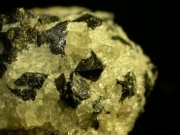Difference between revisions of "Perovskite"
Jump to navigation
Jump to search
(username removed) |
m (Text replace - "== Authority ==" to "== Sources Checked for Data in Record ==") |
||
| Line 26: | Line 26: | ||
|} | |} | ||
| − | == | + | == Sources Checked for Data in Record == |
* Richard S. Lewis, ''Hawley's Condensed Chemical Dictionary'', Van Nostrand Reinhold, New York, 10th ed., 1993 | * Richard S. Lewis, ''Hawley's Condensed Chemical Dictionary'', Van Nostrand Reinhold, New York, 10th ed., 1993 | ||
Revision as of 14:49, 1 May 2016
Description
A mineral composed of calcium oxide and titanium dioxide. Perovskite occurs in nature in Russia and was discovered in 1839 by Gustav Rose. The transparent to opaque stone varies in color from yellow to dark brown. Perovskite has also been made synthetically and is used primarily as a matrix for catalysts.
Synonyms and Related Terms
calcium titanate; perovskita (Esp.); perovskite (Fr., Port.); Perowskit (Deut.); perovskiet (Ned.)
Other Properties
Isometric system with cubic cleavage. Luster = adamantine.
| Composition | CaTiO3 |
|---|---|
| Mohs Hardness | 5.5 |
| Density | 4 |
Sources Checked for Data in Record
- Richard S. Lewis, Hawley's Condensed Chemical Dictionary, Van Nostrand Reinhold, New York, 10th ed., 1993
- Van Nostrand's Scientific Encyclopedia, Douglas M. Considine (ed.), Van Nostrand Reinhold, New York, 1976
- Wikipedia, the free encyclopedia, at http://www.wikipedia.com Comment: http://en.wikipedia.org/wiki/Perovskite (Accessed Sept. 14, 2005)

